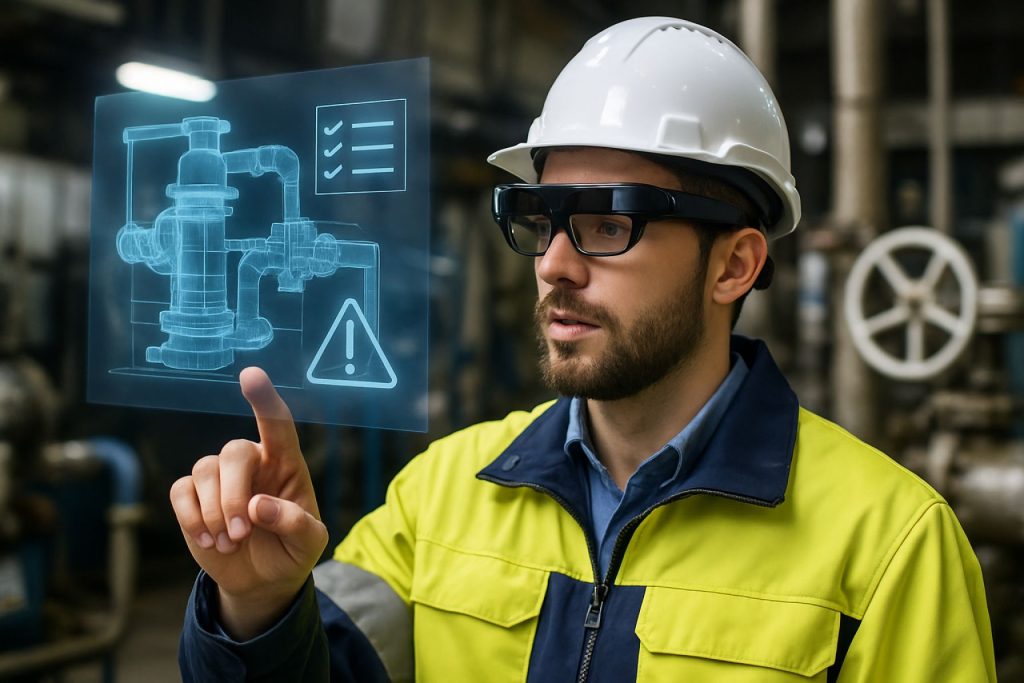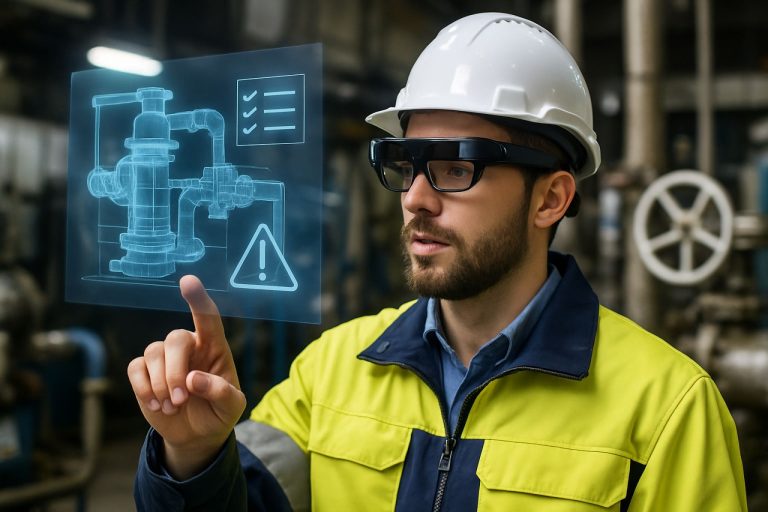
Unlocking New Dimensions in Industrial Training: How Augmented Reality Glasses Are Transforming Workforce Learning and On-the-Job Performance
- Introduction to Augmented Reality Glasses in Industrial Training
- Key Features and Technologies of AR Glasses for Industry
- Benefits of AR Glasses in Workforce Training and Skill Development
- Case Studies: Real-World Applications in Industrial Settings
- Implementation Challenges and Solutions
- Integration with Existing Training Programs and Systems
- Safety Improvements and Risk Reduction
- Cost-Benefit Analysis for Industrial Organizations
- Future Trends and Innovations in AR-Based Industrial Training
- Conclusion and Recommendations
- Sources & References
Introduction to Augmented Reality Glasses in Industrial Training
Augmented Reality (AR) glasses are transforming the landscape of industrial training by overlaying digital information onto the physical world, enabling workers to access real-time guidance, instructions, and data without diverting their attention from the task at hand. Unlike traditional training methods, which often rely on manuals or classroom-based instruction, AR glasses provide immersive, hands-free learning experiences directly in the operational environment. This technology is particularly valuable in industries such as manufacturing, automotive, energy, and aerospace, where complex procedures and safety protocols demand high levels of precision and situational awareness.
The integration of AR glasses into industrial training programs offers several key advantages. Trainees can visualize step-by-step instructions, receive instant feedback, and interact with 3D models or simulations, all while performing actual tasks. This approach not only accelerates the learning curve but also reduces the risk of errors and enhances overall productivity. Furthermore, AR glasses facilitate remote assistance, allowing experts to guide on-site workers through intricate procedures in real time, regardless of geographical location. Such capabilities are increasingly important as industries face workforce shortages and the need for rapid upskilling.
Recent advancements in AR hardware and software have made these solutions more accessible and robust, with devices such as Microsoft HoloLens and Google Glass Enterprise Edition being adopted by leading organizations worldwide. According to Gartner, AR is poised to become a standard tool in industrial training, driving efficiency, safety, and knowledge retention across sectors.
Key Features and Technologies of AR Glasses for Industry
Augmented reality (AR) glasses designed for industrial training integrate a suite of advanced features and technologies tailored to enhance workforce productivity, safety, and knowledge retention. One of the core features is real-time information overlay, where digital instructions, schematics, or alerts are projected directly onto the user’s field of view, enabling hands-free access to critical data during complex tasks. This is often supported by high-resolution, see-through displays and wide field-of-view optics, ensuring clarity and minimal distraction in demanding environments.
Many AR glasses incorporate voice recognition and gesture control, allowing workers to interact with digital content without interrupting their workflow. Integrated cameras and sensors, such as depth sensors and inertial measurement units (IMUs), enable precise spatial mapping and object recognition, which are essential for context-aware guidance and remote expert assistance. For instance, a technician can share a live video feed with a remote expert, who can annotate the worker’s view in real time, streamlining troubleshooting and reducing downtime.
Connectivity is another critical aspect, with most industrial AR glasses supporting Wi-Fi, Bluetooth, and sometimes 5G, ensuring seamless integration with enterprise systems and cloud-based training platforms. Robustness is also prioritized, with many devices meeting industrial standards for dust, water, and impact resistance. Battery life and ergonomic design are continually improving, allowing for extended use in shift-based operations.
Leading AR solutions, such as those from Microsoft HoloLens and RealWear, exemplify these features, offering scalable platforms for immersive, on-the-job training and operational support in manufacturing, maintenance, and logistics settings.
Benefits of AR Glasses in Workforce Training and Skill Development
Augmented reality (AR) glasses are transforming workforce training and skill development in industrial environments by providing immersive, hands-free learning experiences. One of the primary benefits is the ability to deliver real-time, context-aware instructions directly within the worker’s field of view. This minimizes the need for printed manuals or constant supervision, allowing trainees to learn by doing while reducing errors and improving retention rates. For example, AR glasses can overlay step-by-step assembly guides or safety warnings onto machinery, ensuring that workers follow correct procedures without diverting their attention from the task at hand (Microsoft).
Another significant advantage is the facilitation of remote expert assistance. Through live video feeds and annotations, experienced technicians can guide on-site workers through complex tasks, regardless of geographical location. This not only accelerates problem-solving but also reduces downtime and travel costs (Lenovo). Additionally, AR glasses support adaptive learning by tracking user performance and providing instant feedback, enabling personalized training paths that address individual strengths and weaknesses.
Furthermore, AR-based training enhances safety by simulating hazardous scenarios in a controlled, virtual environment. Workers can practice emergency procedures or equipment handling without exposure to real-world risks, leading to greater confidence and competence on the job (PTC). Overall, the integration of AR glasses in industrial training not only boosts productivity and knowledge retention but also fosters a safer, more agile workforce.
Case Studies: Real-World Applications in Industrial Settings
Several industrial sectors have adopted augmented reality (AR) glasses to enhance workforce training, demonstrating tangible benefits in efficiency, safety, and knowledge retention. For instance, Boeing integrated AR glasses into its wire assembly process for aircraft manufacturing. Trainees using AR headsets received step-by-step visual instructions overlaid directly onto their workspaces, resulting in a 25% reduction in assembly time and a significant decrease in error rates.
Similarly, Siemens has implemented AR glasses for maintenance training in its energy and automation divisions. Trainees can visualize complex machinery internals and receive real-time guidance, which has led to faster onboarding and improved troubleshooting skills. In the automotive sector, BMW Group uses AR glasses to train assembly line workers, allowing them to practice intricate tasks virtually before performing them on actual vehicles, thereby reducing costly mistakes and downtime.
Moreover, Shell has deployed AR glasses for safety and equipment training in hazardous environments. Workers can access interactive checklists and hazard alerts hands-free, which has contributed to a measurable decline in workplace incidents. These case studies underscore the versatility and effectiveness of AR glasses in industrial training, highlighting their role in bridging skill gaps and supporting continuous learning in dynamic operational contexts.
Implementation Challenges and Solutions
The implementation of augmented reality (AR) glasses in industrial training environments presents several challenges, despite their transformative potential. One significant hurdle is the integration of AR systems with existing industrial infrastructure and legacy software. Many factories and plants operate with outdated systems that may not natively support AR data streams, necessitating custom middleware or costly upgrades. Additionally, ensuring real-time data synchronization between AR devices and backend systems is critical for safety and accuracy, but can be technically complex.
Another challenge is user adoption and ergonomics. Industrial workers may be resistant to new technologies, especially if AR glasses are perceived as uncomfortable, heavy, or intrusive during long shifts. Addressing these concerns requires careful device selection, user-centered design, and comprehensive training programs. Furthermore, the durability of AR glasses in harsh industrial environments—exposure to dust, moisture, and impacts—remains a concern, prompting manufacturers to develop ruggedized models.
Data security and privacy also pose significant risks, as AR glasses often process sensitive operational information and may include cameras or microphones. Ensuring compliance with industry regulations and implementing robust cybersecurity measures is essential to prevent data breaches or unauthorized access.
To overcome these challenges, organizations are adopting phased implementation strategies, starting with pilot projects to demonstrate value and gather user feedback. Collaboration with AR technology providers for custom solutions, investment in worker training, and the use of secure, industrial-grade AR platforms are also proving effective. Industry leaders such as Microsoft and Lenovo are actively addressing these issues by offering enterprise-focused AR solutions tailored for industrial use.
Integration with Existing Training Programs and Systems
Integrating augmented reality (AR) glasses into existing industrial training programs and systems requires careful alignment with current workflows, learning management systems (LMS), and safety protocols. Successful integration hinges on the ability of AR devices to interface seamlessly with digital resources such as instructional manuals, real-time data feeds, and performance tracking tools. Many AR platforms now offer APIs and software development kits (SDKs) that facilitate connectivity with popular LMS platforms, enabling trainers to assign, monitor, and assess AR-based modules alongside traditional e-learning content. This interoperability ensures that training records remain centralized and accessible, supporting compliance and audit requirements in regulated industries (Occupational Safety and Health Administration).
Another critical aspect is content adaptation. Existing training materials—such as standard operating procedures, maintenance checklists, and safety instructions—must be converted into AR-compatible formats. This often involves creating 3D models, interactive overlays, and step-by-step visual guides that can be accessed hands-free through AR glasses. Collaboration between subject matter experts, instructional designers, and AR developers is essential to ensure accuracy and usability (National Institute of Standards and Technology).
Finally, integration efforts should address user adoption and change management. Providing pilot programs, user training, and technical support can help overcome resistance and ensure a smooth transition. When thoughtfully implemented, AR glasses can enhance existing training systems by delivering immersive, context-aware instruction that improves knowledge retention and operational efficiency (Gartner).
Safety Improvements and Risk Reduction
Augmented reality (AR) glasses are transforming safety protocols and risk management in industrial training environments. By overlaying digital information directly onto the user’s field of view, AR glasses provide real-time, context-sensitive guidance that helps workers identify hazards and follow safety procedures more effectively. For example, during equipment operation or maintenance, AR glasses can highlight dangerous components, display step-by-step instructions, and issue immediate alerts if a user approaches a restricted or hazardous area. This hands-free access to critical information reduces the likelihood of human error and ensures that safety protocols are consistently followed.
Moreover, AR glasses enable immersive simulation of emergency scenarios, allowing trainees to practice responses to fires, chemical spills, or equipment malfunctions in a controlled, risk-free environment. Such experiential learning has been shown to improve retention of safety procedures and increase confidence in handling real-life incidents. Additionally, supervisors can monitor trainees remotely through live video feeds, providing instant feedback and intervention if unsafe actions are detected. This capability not only enhances individual safety but also supports a culture of continuous improvement and proactive risk management.
Several industrial leaders have reported measurable reductions in workplace accidents and near-misses after integrating AR-based training solutions. According to National Institute of Standards and Technology, AR technologies can significantly improve situational awareness and compliance with safety standards. As AR glasses become more sophisticated and widely adopted, their role in minimizing risks and safeguarding workers is expected to grow even further.
Cost-Benefit Analysis for Industrial Organizations
A comprehensive cost-benefit analysis is essential for industrial organizations considering the adoption of augmented reality (AR) glasses for training purposes. The initial investment in AR hardware, software licenses, and integration with existing systems can be significant. For example, enterprise-grade AR glasses such as Microsoft HoloLens or Vuzix M4000 typically range from $1,000 to $3,500 per unit, not including custom software development and IT infrastructure upgrades Microsoft. However, these upfront costs must be weighed against the long-term benefits.
Key benefits include reduced training time, improved knowledge retention, and enhanced worker safety. AR glasses enable hands-free, on-the-job guidance, allowing trainees to learn complex procedures in real time without the need for physical supervision. Studies have shown that AR-based training can reduce error rates by up to 40% and decrease training time by 30-50% compared to traditional methods PwC. Additionally, AR can minimize downtime by providing instant access to digital manuals and remote expert support, leading to increased productivity.
Indirect benefits include lower travel costs for trainers, reduced material waste, and improved compliance with safety protocols. Over time, these factors contribute to a favorable return on investment (ROI), especially in industries with high turnover or complex machinery. Nevertheless, organizations must also consider potential challenges such as device maintenance, user adoption, and data security. A thorough pilot program and stakeholder engagement are recommended to maximize the value of AR training solutions Gartner.
Future Trends and Innovations in AR-Based Industrial Training
The future of augmented reality (AR) glasses in industrial training is poised for significant transformation, driven by rapid advancements in hardware, software, and connectivity. One emerging trend is the integration of artificial intelligence (AI) with AR glasses, enabling real-time contextual assistance, predictive maintenance, and adaptive learning experiences tailored to individual workers’ needs. For example, AI-powered AR systems can analyze user performance and provide instant feedback or suggest corrective actions, enhancing both safety and efficiency on the shop floor (Microsoft).
Another innovation is the development of lighter, more ergonomic AR glasses with improved field of view, battery life, and hands-free interaction capabilities. These improvements address common barriers to adoption, such as user fatigue and device discomfort, making AR solutions more practical for extended industrial use (Lenovo). Additionally, the integration of 5G connectivity is set to revolutionize AR-based training by enabling seamless streaming of high-resolution content and real-time collaboration between remote experts and on-site trainees (Ericsson).
Looking ahead, the convergence of AR with the Internet of Things (IoT) will allow AR glasses to access live data from connected machinery, providing trainees with up-to-date operational insights and interactive troubleshooting guides. As these technologies mature, AR-based industrial training is expected to become more immersive, personalized, and scalable, ultimately reshaping workforce development and operational excellence across manufacturing, energy, and logistics sectors.
Conclusion and Recommendations
In conclusion, augmented reality (AR) glasses have demonstrated significant potential to transform industrial training by providing immersive, hands-on learning experiences that enhance knowledge retention, safety, and operational efficiency. The integration of AR glasses into training programs allows workers to access real-time, context-sensitive information, interactive simulations, and remote expert guidance, all while remaining engaged in their physical environment. This technology addresses key challenges such as skill gaps, high training costs, and the need for rapid upskilling in dynamic industrial settings, as highlighted by PwC and Deloitte.
To maximize the benefits of AR glasses in industrial training, organizations should consider the following recommendations:
- Conduct thorough needs assessments to identify specific training areas where AR can deliver the most value.
- Invest in user-friendly, durable AR hardware that is compatible with existing safety equipment and industrial environments.
- Develop or source high-quality, customized AR training content tailored to the unique workflows and safety protocols of the organization.
- Provide comprehensive onboarding and ongoing support to ensure user adoption and address potential resistance to new technology.
- Continuously evaluate training outcomes and gather user feedback to refine AR applications and measure return on investment, as recommended by McKinsey & Company.
By strategically implementing AR glasses, industrial organizations can foster a culture of continuous learning, improve workforce competency, and maintain a competitive edge in an increasingly digital landscape.
Sources & References
- Microsoft HoloLens
- RealWear
- Lenovo
- Boeing
- Siemens
- Shell
- National Institute of Standards and Technology
- PwC
- Deloitte
- McKinsey & Company



